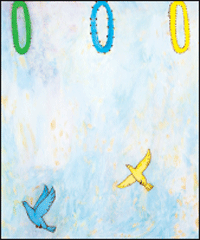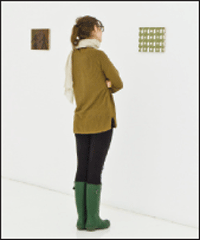Trio of exhibitions offer unique concoctions
 [/media-credit]
[/media-credit]
RIDLEY HOWARD: SLOWS
Through February 25
At Leo Koenig Inc.
545 W. 23rd St. (btw. 10th & 11th Aves.)
Hours: 10am-6pm, Tues.-Sat.
Call 212-334-9255 or visit leokoenig.com
“Slows” proves that Howard is one of the few artists who can work equally well in figuration and abstraction. His paintings enable us to find characteristics of the former in the latter and vice versa. His geometric shapes easily translate into flattened architectural structures seen from above, while his figures or depiction of a building can be dissected into individual abstract forms. Inspired by avant-garde filmmakers of the late 1960s/1970s, Howard stresses that the ordinary can be psychologically charged and steeped in symbolic meaning.
 [/media-credit]
[/media-credit]PAUL HEYER/VIRGINIA POUNDSTONE: “I KNOW THAT I AM AWAKE”
Through February 26
At Rachel Uffner Gallery
47 Orchard St. (btw. Grand & Hester Sts.)
Hours: 11am-6pm, Wed.-Sun.
Call 212-274-0064 or visit racheluffnergallery.com
This exhibition brings together work by the Los Angeles-based Paul Heyer and Virginia Poundstone, who lives and works in New York. Heyer works in painting, his compositions bordering on the whimsical. Birds, blue leaves set against a yellow sky and a street lamp enveloped by a sea of swirling leaves in red light make up some of his imagery in this particular installation. They are poetic snapshots of a world that we know from children’s books illustrations rather than daily life — dreamlike meditations on a “could be-should-be” wish for reality. Heyer’s loose and spontaneous brushwork further adds a sense of animated positivism.
In contrast, Poundstone’s sculptures exude post-conceptual cool. She works with ceramic tile, brass and steel. Her works are organized and largely geometric — except for the occasional swirls of steel, onto which she prints digital images of rhododendron. In Poundstone, we find a futuristic vision of nature. It might evoke some characteristics of the organic but its presentation is highly artificial. As a result, her works translate as iconic reminders that the world as we know it is fragile and seriously threatened. Both these artists ponder nature — but whereas Heyer provides an almost nostalgic look at the world, Poundstone presents her take with more reserve and dramatic impact.
It is in the combination of these two unlike worldviews that this installation becomes the more thought-provoking. After all, we are only truly awake if we look back, as well as well as forward.
JEAN-FRÉDÉRIC SCHNYDER
Through February 26
At Swiss Institute1
8 Wooster St. (btw. Canal & Grant Sts.)
Hours: 12-6pm, Wed.-Sun.
Call 212-925-2035 or visit swissinstitute.net
This solo presentation of the well-established and self-taught Swiss artist navigates between charm and repulsion. Small canvases (35 of them) are installed in a vast space, forcing the viewer to slowly narrow in on the subject. While coined “Landschaft’ [Landscape], Schnyder is specifically pondering the concept of home (with all its inherent ideals, threats and colors). The series dates from 1990 and 1991, and each painting offers a variation on a small house — the archetype of a domestic microcosm. His imagination is rich and he finds as much inspiration in the witch’s shack from Hansel and Gretel as he does in the abstract silhouette of a house set against an abstract and heavily impasto-ed background. Stylistically he is hard to classify. There is tongue-in-cheek humor in a scene of two dogs watching a Pluto cartoon in a kitchy living room, for example — and there is the idyllic rendition of a house snowed in and enveloped by a mysterious pine forest. There also is darkness. One composition depicts a house set in a vast landscape with smoke pouring out its chimney, forming a Swastika. Another shows a house set next to a large burning candle, dramatically stressing that all things must pass.
The startling diversity is the product of Schnyder’s dedication to a thorough investigation. He examines his subjects from all angles and works serially. For his installation at the Venice Biennale in 1993, he completed a body of work entitled “Wanderung” (“Hike”). To prepare, he hiked along a Swiss national highway from East to West and painted 119 vistas of the traffic, portraying scenic Switzerland from an unusually mundane perspective. While Schnyder’s process can be conceptual and his tone ironic, it is the sense of purity found in his hand that makes his work hard to place. He embodies the oxymoron of a naïve satirist. Despite a long and successful career — including his participation at the legendary Documenta 5 in Kassel, Schnyder has remained little known outside of Europe. This exhibition offers an excellent opportunity to brush up on an obscure visionary.

















